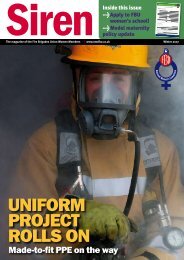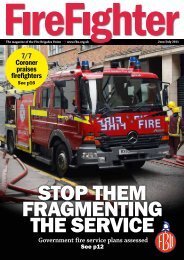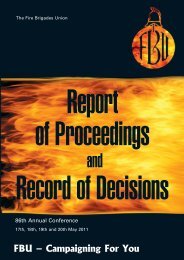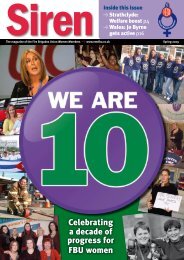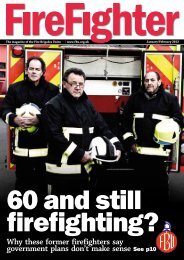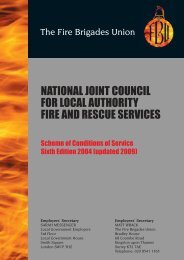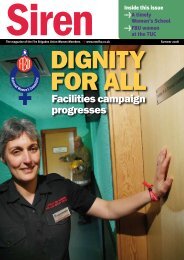Report - Fire Brigades Union
Report - Fire Brigades Union
Report - Fire Brigades Union
You also want an ePaper? Increase the reach of your titles
YUMPU automatically turns print PDFs into web optimized ePapers that Google loves.
SECTION J — HEALTH & SAFETY<br />
In October 2010 the HSE released its consolidated report<br />
based on the eight inspections carried out so far. The report<br />
concluded that:<br />
1.11 There are 2 specific areas where the findings<br />
across all the inspections are consistent. They<br />
confirm the fundamental importance of 2<br />
complementary aspects of effective safety<br />
management, namely:<br />
●<br />
●<br />
Competence assessment for firefighters at all<br />
levels including management;<br />
A proportionate approach to risk assessment.<br />
1.15 Some other matters that need to be further<br />
considered and addressed by the FRS as a whole<br />
also emerged. These are:<br />
●<br />
●<br />
●<br />
●<br />
The extent to which firefighters should or<br />
should not take risks to save property;<br />
Whether retained duty staff can fulfill all of the<br />
operational duties of a firefighter given the time<br />
they have available for training;<br />
Clarity about how FRS can meet public<br />
expectations on water rescue;<br />
How best to develop and implement consistent<br />
national guidance and improve interoperability<br />
on those matters that affect every FRS.<br />
The HSE intends to carry out four additional inspections of fire<br />
and rescue services. It has indicated that it will use guidance<br />
published by CFRA as a benchmark and it expects to find<br />
significant improvement in the areas identified in the<br />
consolidated report.<br />
J5 Brigade safety representatives’<br />
training course<br />
This course was held in March at Wortley Hall. Head office<br />
input included John McGhee, national officer, and Trevor Cave,<br />
FBU education. The TUC tutors supporting the course were<br />
John Botterill and Katherine Fry, Leeds City College, Trade<br />
<strong>Union</strong> Education Department.<br />
Presentations came from Sue Parkyn, head of police, prisons,<br />
fire and sector support for the HSE, and Dave Sibert, fire safety<br />
and IRMP advisor for the FBU.<br />
Tutor-led discussions focused on:<br />
● the role of safety representatives within IRMP;<br />
● fire service for 21st century presentation;<br />
● operational guidance programme; and<br />
● dynamic risk assessment.<br />
Very positive feedback was received from students.<br />
J6 Serious accident investigation<br />
The serious accident investigation manual has been agreed and<br />
published. The serious accident investigation kit will be rolled<br />
out once the distribution list has been finalised. It is intended<br />
to develop a TUC-accredited course on serious accident<br />
investigation and roll this out over the next two years.<br />
J7 CFRA operational guidance<br />
programme<br />
In 2008 the chief fire and rescue advisor (CFRA) commissioned<br />
12 projects under the general control and scrutiny of the<br />
Operational Guidance Programme Board. Each project has a<br />
director appointed by CFRA and board to oversee the project.<br />
The FBU has a position on each of the boards. The FBU fully<br />
support the development of central guidance. The projects are:<br />
● Respiratory protection equipment (revision of TB 1/97);<br />
● Management of risk at operational incidents (H and S,<br />
DRA);<br />
● Hazardous materials including CBRN and decontamination;<br />
● Tunnel/underground;<br />
● Railway incidents;<br />
● Major floods;<br />
● National coordination and advisory framework;<br />
● Information to operational staff on premises risk;<br />
● Aircraft incidents;<br />
● Marine incidents;<br />
● Safe working in, on, or near water;<br />
● Immediate emergency care;<br />
● Fighting fires in timber-framed buildings; and<br />
● Communications and mobilising.<br />
Four operational guidance manuals are due for publication early<br />
in 2011. These are:<br />
● Hazardous materials including CBRN and decontamination;<br />
● Tunnel/underground;<br />
● Railway incidents; and<br />
● Aircraft incidents.<br />
The FBU supports the publication of operational guidance with<br />
some reservations over the development and intended use of<br />
generic standard operating procedures (GSOPs). A clear area of<br />
weakness in fire and rescue service planning has been overreliance<br />
on what is termed dynamic risk assessment (DRA)<br />
rather than thorough pre-planning for emergency response. It<br />
is now widely accepted (HSE, CFRA, FBU and CFOA) that<br />
DRA does not provide safe systems of work.<br />
The FBU has found that the process for emergency planning<br />
and software such as fire service emergency cover (FSEC) is<br />
flawed because a vital element has been neglected. This<br />
element became known as worst-case planning scenarios<br />
(WCPSs) during development of risk-based emergency cover.<br />
FBU Annual <strong>Report</strong> 2011 157





